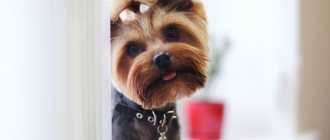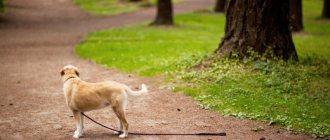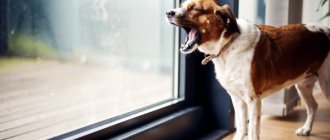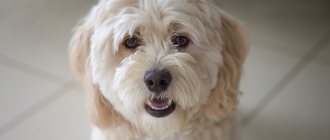With the arrival of a puppy in the house, the owners begin a difficult period of life. While the dog is still very young and does not understand the rules of existence in a new family, it is very important to start raising him now. It is the owner who must explain to the new member of the small community what is good and what is bad. And of course, teach the puppy to go to the toilet only in designated areas.
How to stop a puppy from littering the house
Little puppies learn and experience the world like children, and the owner’s task is to teach the pet good manners from the first day it arrives in the house. Puppies are in quarantine for the first 3.5 - 4 months of life due to mandatory immunization against viral infections. Accordingly, all this time they are in the apartment and are forced to crap in the house. During isolation, the puppy develops a strong habit of going to the toilet in its den.
There are several secrets that will help stop your puppy from shitting all over the house:
- It is necessary to choose a separate room for the baby’s toilet - it’s good if it is a balcony or a storage room.
- Cover the entire floor surface in the designated room with paper or a diaper.
- Every time after sleeping and eating, take the puppy for natural needs to the space allocated for the toilet.
- Do not let the pet out of this room until the pet has done its business.
- After emptying the intestines and bladder, praise your pet vigorously so that he understands that the owner approves of his actions.
- During the day, carefully monitor the baby, and at the first signs of going to the toilet (sniffing, circling in one place), immediately pick up the dog and carry it to the room for defecation. You cannot grab a puppy when he has already started peeing; until he is 4 months old, he does not fully control this process and cannot stop it. There will be only one result - a frightened pet and a path of urine throughout the apartment.
- Gradually, your four-legged friend will choose one place in the designated room to defecate, then all other diapers and newspapers can be removed.
But you should not leave your dog alone in a confined space for a long time, especially without light, as this can lead to fear of loneliness or claustrophobia.
Puppies under 4 months of age practically cannot tolerate it if access to the diaper room is limited (the door is closed), you must be prepared for a puddle to appear anywhere . Moreover, during this period, the baby may simply not reach the diaper if it is far away. You can’t scold a dog for this, this is a physiological feature of the body, it’s not the pet’s fault.
If there was a “problem” and the dog went in the wrong place, although the owner tried his best and did everything correctly - in no case should you shout at the baby, physically punish or poke your nose into a pile (puddle). This can lead to terrible stress and fear for the owner; as a result, the puppy will crap, but hide it under carpets, pillows, bedspreads, or even eat the object of the owner’s anger. Further, the owner’s fear will negatively affect the building of relationships and subsequent education.
Basic rules for teaching a puppy to pee on the street
Before you begin to accustom your puppy to walking, you need to remember one important condition - a puppy, starting from 5 months, can tolerate going to the toilet for no more hours than he is months old. If your pet is left at home alone for a longer period of time, he should have access to a diaper, otherwise there will be unpleasant surprises on the floor.
What you need to do to teach your puppy to go to the toilet outside:
- Walk after eating and sleeping.
- Show your approval by defecating in the street.
- Take water for walks and actively water your pet.
- Organize active games (physical exercise speeds up metabolism).
- Praise for sniffing marks (working with the nose triggers the mark reflex).
- Do not run home immediately after defecation.
- The duration of the walk should correspond to the dog's activity.
- For unsure puppies, taking the toilet out of the house is a suitable method.
It often happens that a dog walks along the street for a long time and persistently, but runs home to the toilet, even during long walks . This may be due to the baby's lack of self-confidence. During quarantine, he gets used to certain smells; when he goes outside, the dog is bombarded with a huge amount of scent information. There are several ways out of this situation:
- Walk down the street until the puppy can't stand it anymore.
- Take the diaper out into the yard and walk around it.
- To add self-confidence to your dog while he is in quarantine, carry the baby outside in your arms.
When dealing with a timid dog, it is especially important to show what he is doing right and to minimize negativity in communication. When defecating in the wrong place, ignore it; when defecating on the street, praise it very actively and treat it with treats.
Not for an owl
So, from the moment the puppy appears in the house until he reaches 6 months, you need to rearrange your daily routine in such a way as to walk him at least four times a day. The first departure is early in the morning, at about 5-6 o'clock. After this, you will have enough time to do your usual chores and get ready for work. Be sure to take another walk before leaving. This will make it easier for the puppy to endure.
Lunch break should be an occasion to look home. By going outside for just 15 minutes, you will provide your baby with the opportunity to wait until the evening without unnecessary discomfort. And after dinner you need to devote at least 2-3 hours to a walk.
Why did an adult dog start shitting at home?
It is very difficult to give a definite answer to the question - why does an adult dog shit at home . There are probably as many reasons for this phenomenon as there are pets peeing on the carpet. And before solving the problem, it is necessary to understand what its background is.
The main types of problems are physiological or psychological. Each variant has several dozen subspecies. The main versions are presented below, but if nothing helps, you need to contact a zoopsychologist who will help you understand the specific problem.
Physiological ailments
Health problems are often the result of unpleasant surprises at home. In certain situations, the dog simply cannot wait to go for a walk.
The main physiological reasons that lead to incontinence in dogs:
- Internal organ injuries.
- Inflammation of the bladder (cystitis).
- Kidney diseases.
- Problems with the gastrointestinal tract.
- Side effects of medications.
- Overdose of veterinary drugs.
- Hypothermia.
- Viral infections.
- Age.
You can get rid of bowel movements in the house by carefully analyzing the situation. If there is even the slightest suspicion of physiology, it is necessary to urgently contact a veterinary clinic. Carry out all the necessary procedures to identify the factor that led to bowel movements in the apartment. After eliminating the root cause, the effect will disappear on its own.
Psychological abnormalities
Anything related to psychological characteristics is much more difficult to correct. You need to very carefully delve into the delicate soul of a dog.
The main psychological factors why a dog craps at home:
- Fear, phobias.
- Substrate habit.
- Diffidence.
- Too much time without walking.
- Demand for attention.
- Change of usual environment (can be attributed to stress).
- Experienced stress.
- An uncorrected habit of walking indoors since puppyhood.
All problems can be dealt with only by finding out the real reason for the manifestation of destructive behavior. The main obstacle in this situation is that it is impossible to know exactly how the pet behaves in the absence of its owners, and this is very important. In the age of high technology, nothing is impossible anymore - you can leave the camera and watch what happens when the dog is left alone.
If the problem returns
It also happens. The breeder informs the owner of the approximate time frame at which the puppy stops peeing at home. This is usually closer to 6 months of age. But sometimes after a while the owner is faced with the fact that puddles and piles begin to appear again. If we are talking about a young dog, then the problem is most likely psychological in nature:
- Excessively strong emotions. When a dog is happy to meet its beloved owner, it may wet itself. Or she is afraid of punishment for the trick. If people yell at a dog and beat it for mischief, it will do more mischief.
- The reason may also be longing for the owner. Experiments were conducted when cameras were installed in the homes of puppy owners who complained about such problems. As a result, it was possible to see that when the owners are at home, the dog behaves perfectly. She asks to go to the toilet, she is calm and happy. But as soon as they leave, she begins to rush and howl. Sometimes, unable to withstand the melancholy, she relieves herself and nervously gnaws on things.
- Problems of master's authority. A young dog may tend to be dominant. And if the owner demonstrates excessive gentleness, then the pet feels unpunished.
It happens that several months of training go to waste, and, at first glance, it is not clear why. The puppy stopped peeing on the diaper or the teenager began to relieve himself in the corners - pay attention to the points listed above. Perhaps the problem can be solved quite simply.
How to toilet train a dog
To prevent surprises from appearing in the form of numerous piles and puddles throughout the apartment, it is necessary to constantly work on this issue. You can train your dog to toilet yourself only if this phenomenon is not associated with stress and phobias. In case of psychological abnormalities, a zoopsychologist must work with the animal.
If your pet shows symptoms of phobias and fears, you should not use sedatives and cages, this will only worsen the problem.
Learning sequence and problem solving
After eliminating physiological causes, that is, if the owner knows for sure that the dog is completely healthy, you can begin to solve the problem of defecation in the house.
- Fears, phobias, stress. A number of these problems can only be resolved by an animal psychologist; one must proceed from the individuality of the situation.
- Substrate habit . The solution is easy - the canvas on which the dog is used to doing his business is taken outside.
- Too much time without walking . You must understand that a dog is a living creature and cannot tolerate more than the capacity of its bladder. Regulated by more frequent walking.
- Diffidence . The most common problem in bitches. Males with the onset of puberty, thanks to the release of a huge amount of testosterone into the blood, become more self-confident - they begin to mark their territory, and as a result, they get used to going to the toilet on the street. In females, in the absence of self-confidence, it is necessary to work on “self-esteem”.
- Demand for attention . Dogs that are strongly focused on the owner, but deprived of care (as a rule, young and active individuals) can attract attention to their person in this way. The dog knows that he will do something nasty, the owner will come and scold him, negativity is better than indifference. The situation can be corrected by a correctly built relationship between man and dog in a pack.
- The habit of going to the toilet at home since puppyhood. If the baby has just started to be taken outside, he may still crap in the house simply out of habit. You can get rid of this quickly - you need to completely eliminate the possibility of defecation in the apartment (take the dog and leave the house for the whole day, the baby will have no choice).
Secrets of re-education
The main sacrament of behavior correction is positivity, that is, not punishing the dog for wrongdoing, but praising it for correct actions. Thus, the dog learns to monitor the owner’s reaction, and not avoid communication. Positive reinforcements increase your pet's self-esteem and help you become more confident.
Prohibited Methods
- If a dog shits at home, there is absolutely no point in punishing it unless it is caught red-handed. You can understand the owner - his nerves are not made of steel. But in fact, punishment is not an effective method in correcting destructive behavior.
- Moreover, negative manifestations on the part of the owner entail distrust of the dog. Then there are problems with training and building relationships.
Allowed Methods
It is allowed to use negative reinforcement instead of punishment. Only it should not be very cruel, so as not to traumatize the animal’s psyche. At the moment of defecation (not after!) in the wrong place, you can clap your hands loudly or throw a bunch of keys near the dog. When the pet interrupts the act of defecation out of fright, she must be praised. As a rule, several such repetitions are enough for the dog to understand that the owner is not pleased with surprises on the carpet.
This method will not work with very young puppies; they cannot interrupt the action they have started.
Chemicals
Modern veterinary pharmacies offer a lot of sprays for toilet training dogs. But, they only work if the pet is accustomed to the substrate. They do not fight other physiological and mental disorders.
But they perfectly help get rid of unpleasant odor after bowel movements and bladder.
Folk remedies
There are several folk methods on how to stop a dog from shitting in its favorite place. You can make an essence with the addition of:
- Citrus juice.
- Vinegar.
- Mint.
- Wormwood.
- Eucalyptus.
- Cinnamon.
- Any other ingredient with a strong odor.
A dog's nose is very sensitive; a strong, pronounced smell can scare him away from his favorite place to defecate.
What do we have to do
If there is a clearly thought out scheme, then acting on it is much easier. After all, if you just dream about those days when the puppy stops peeing at home, it won’t make them come any faster. You can proceed as follows. In almost all apartments, the toilet is located close to the front door. Therefore, we slowly move the puppy’s tray to the toilet and teach him how to use it. The door should be left ajar so that the baby can push it with his paw. When this moment passes, the door closes.
Then everything depends on you. As soon as the puppy gives a signal that he wants to go to the toilet, that is, he pushes the door with his paw, you grab the leash and run out into the street with him. You can’t wait long, so if it’s not frosty outside, try to act quickly. Of course, you will have to constantly take time off from your work, but you just need to get through this period.
How to train a dog to go to the toilet: expert advice
A number of parting words that will definitely help stop your pet from shitting anywhere:
- Thoroughly understand the cause of the problem.
- It is good to socialize your dog with its relatives.
- Follow the feeding and walking schedule.
- Young dogs should not be left unattended for long periods of time.
- Combat fears and phobias with the help of a qualified specialist.
- Always leave access to the tray or diaper.
- Timid dogs should be walked for long periods of time and in different places.
- Walk the puppies immediately after sleeping and feeding.
- Organize active games in the fresh air.
- Be sure to encourage the correct choice of place to defecate.
Raising a dog is actually not difficult. The main thing that is required from the owner is patience and consistency. This is a very small price to pay for the boundless loyalty and love that animals give to people.
4.5 / 5 ( 4 voices)
When can I remove the diaper?
It will take some time to finally form a habit. The more often you take your dog for walks, the sooner he will understand what you expect of him.
As soon as you notice that your pet begins to ask to go outside and visit the toilet organized in the apartment less and less often, you can remove the old diaper. To be on the safe side, we recommend treating the previous area with a special solution that removes odors. And, of course, do not forget about the rules of good manners - when going outside, be sure to take cleaning bags with you.
Methods of punishment
Remember, a dog is a very smart creature that reacts quite sharply to the mood of its owner. If you do not offend your pet, he will respond to any of your requests.
Of course, it is difficult to calmly react to a puddle or a pile made on the path, but you can show your dissatisfaction with the dog.
- Change your tone of voice and scold your dog for what he has done.
- Take away your favorite toy and let him play only when the dog defecates outside.
- As soon as you see that the dog wants to relieve itself, use the command: “Ugh! It is forbidden!". She needs to understand how you feel about this behavior.
Do you know what to do if your dog has diarrhea? All about how to cure diarrhea.
Has your pet been bitten by a tick? Read about what piroplasmosis is and why it is dangerous.
Wondering how long pregnancy is in dogs? The answer to this is in our article.
Application of various means
Today in pet stores you can buy various products that can quickly wean a dog from bowel movements at home and stop a dog from barking at home. The correct result will be obtained by the integrated use of several means at the same time. It is convenient to use a litter tray treatment product whose smell attracts dogs. Its use will help the puppy quickly get used to the new toilet.
Among other means, repellent drugs are distinguished. They are supposed to treat problem areas; the smell instantly discourages the pet from marking an area of the territory. Table vinegar has a similar effect and is recommended for use in extremely small doses, for fear of depriving the dog of its sense of smell. It’s as easy as rinsing the floor with a solution of water and 4-5 drops of vinegar. The dog will begin to be suspicious of the previously chosen area and avoid leaving a mark there.
Pet stores offer dog owners special wipes impregnated with an attractive scent. It is recommended to place the devices at the bottom of the tray, trying to help the baby get used to the new toilet. The use of absorbent diapers will help when puddles appear in the rooms; they can be easily placed around the premises, and when the puppy has relieved himself, throw them away.
Consult your doctor
Sometimes the problem lies in your pet's physiology. For example, a female dog may continue to pee periodically at home until she is two years old. This is due to the formation of the hormonal system. Periodically, the dog begins to leave a number of small puddles. This is a phenomenon that goes away after the first birth or with age. It occurs, according to statistics, in one out of 5-7 females. If the problem appears in a young dog that has been trained to relieve itself on the street, then pay attention to the following factors:
- In cold weather, a dog can catch a cold. This leads to various kinds of inflammatory processes. It is possible that increased urination is a consequence of this.
- Jealousy. If the family has a child, a cat or another dog, then your pet may simply start leaving puddles out of jealousy. Or maybe mark the territory, showing the “newcomers” who is boss in this house.
- Severe stress.
As you can see, the question of how many months a puppy stops peeing at home remains open: there are too many nuances here. But normally this happens at 6-7 months.










